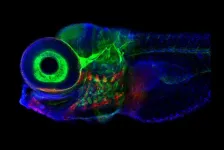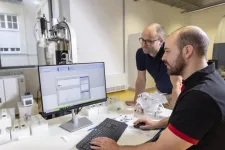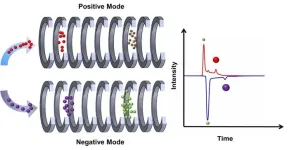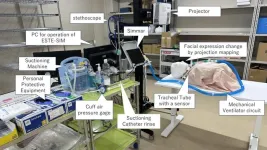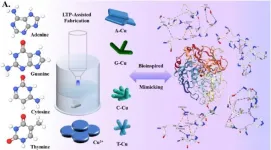(Press-News.org) Working with week-old zebrafish larva, researchers at Weill Cornell Medicine and colleagues decoded how the connections formed by a network of neurons in the brainstem guide the fishes’ gaze. The study, published Nov. 22 in Nature Neuroscience, found that a simplified artificial circuit, based on the architecture of this neuronal system, can predict activity in the network. In addition to shedding light on how the brain handles short-term memory, the findings could lead to novel approaches for treating eye movement disorders.
Organisms are constantly taking in an array of sensory information about the environment that is changing from one moment to the next. To accurately assess a situation, the brain must retain these informational nuggets long enough to use them to form a complete picture—for instance, linking together the words in a sentence or allowing an animal to keep its eyes directed to an area of interest.
“Trying to understand how these short-term memory behaviors are generated at the level of neural mechanism is the core goal of the project,” said senior author Dr. Emre Aksay, associate professor of physiology and biophysics at Weill Cornell Medicine, who led the study, together with Dr. Mark Goldman at the University of California Davis and Dr. Sebastian Seung at Princeton University.
Modeling a Dynamical System
To decode the behavior of such neuronal circuits, neuroscientists use the tools of dynamical systems, which involve building mathematical models that describe how the state of a system changes over time, where the current state determines its future states according to a set of rules. A short-term memory circuit, for example, will remain in a single preferred state until a new stimulus comes along, causing it to settle into a new activity state. In the visual-motor system, each of these states can store the memory of where an animal should be looking.
But what parameters help to set up that type of dynamical system? One possibility is the anatomy of the circuit: the connections that form between each neuron and how many connections they make. Another likely possibility is physiological strength of those connections, which is established by a myriad of factors like the amount of neurotransmitter being released, the type of synaptic receptors and the concentration of those receptors.
To understand the contributions from circuit anatomy, Dr. Aksay and his collaborators looked to larval zebrafish. By five days of age, these fishlets are swimming around and hunting prey, a skill that involves sustained visual attention. Importantly for the research team, the brain region that controls eye movement is structurally similar in fish and mammals. But the zebrafish system contains only 500 neurons. “So, we can analyze the entire circuit—microscopically and functionally,” Dr. Aksay said. “That’s very difficult to do in other vertebrates.”
Zebrafish Shed Light on Neuronal Circuits
Using an array of advanced imaging techniques, Dr. Aksay and colleagues identified the neurons that participate in controlling the animals’ gaze and then determined how these neurons are wired together. They discovered that the system consists of two prominent feedback loops, each containing three clusters of tightly connected cells. The researchers used this distinctive architecture to build a computational model. They found that their artificial network could accurately predict activity patterns of the zebrafish circuit which they validated by comparing their results to physiological data.
“I consider myself a physiologist, first and foremost,” Dr. Aksay said. “So, I was surprised how much of the behavior of the circuit we could predict from the anatomical architecture alone.”
Next, the researchers will explore how the cells in each cluster contribute to the behavior of the circuit—and whether the neurons in the different clusters have distinct genetic signatures. Such information could allow clinicians to therapeutically target those cells that may malfunction in eye movement disorders. The findings also provide a blueprint for unraveling the more complex computational systems in the brain that rely on short-term memory, such as those involved in deciphering visual scenes or understanding speech.
This study was supported in part by the National Institutes of Health grants from the National Institute of Neurological Disorders and Stroke R01 NS104926 and Brain initiative award 5U19NS104648; the National Eye Institute R01 EY027036, R01 EY021581 and K99 EY027017; and the National Cancer Institute UH2 CA203710.
END
New model of neuronal circuit provides insight on eye movement
2024-11-22
ELSE PRESS RELEASES FROM THIS DATE:
Cooking up a breakthrough: Penn engineers refine lipid nanoparticles for better mRNA therapies
2024-11-22
Penn Engineers have cooked up a new way to improve mRNA delivery, developing an optimal “recipe” for ionizable lipids — key ingredients in lipid nanoparticles (LNPs), the molecules behind the COVID-19 vaccines and other innovative therapies. The method, described in Nature Biomedical Engineering, mirrors the iterative process of developing a culinary dish and may lead to safer, more effective mRNA vaccines and therapeutics.
Just as a chef perfects a dish by experimenting with flavors and textures, the researchers used an iterative process, testing variations to find the ideal structure ...
CD Laboratory at Graz University of Technology researches new semiconductor materials
2024-11-22
The global production of semiconductors is growing rapidly and with it the demand for primary products, especially crystalline silicon. However, its production is very energy-intensive and only half of the raw silicon used is actually utilised. This leads to large quantities of waste. In the Christian Doppler Laboratory for New Semiconductor Materials Based on Functionalized Hydrosilanes, which opened today, a team led by laboratory manager Michael Haas from the Institute of Inorganic Chemistry at Graz University of Technology (TU Graz) is carrying out research on alternatives. Funded by the Austrian Ministry of Economics and Labour, the researchers are working with ...
Animal characters can boost young children’s psychological development, study suggests
2024-11-22
Children’s books are full of animal characters whose antics capture the hearts and inspire the imaginations of their young readers.
However, a new study has shown that iconic characters such as Peter Rabbit – or Toad and Ratty from The Wind in the Willows – can also play an important role in children’s psychological development.
The research explored the extent to which different non-human characters influence children’s theory of mind skills, which include the ability to read and predict social changes in the environment through tone of voice, choice of words, or facial expression.
For ...
South Korea completes delivery of ITER vacuum vessel sectors
2024-11-22
The ITER vacuum vessel sectors, manufactured in South Korea, have been successfully delivered to the ITER construction site in Cadarache, France. South Korea was responsible for manufacturing 4 out of the 9 sectors that make up the ITER vacuum vessel. Starting with the delivery of the first sector in 2020, South Korea has now completed all four sectors, fulfilling its commitment to this significant international project.
The ITER vacuum vessel is a key component that sustains the ultra-high-temperature plasma required for nuclear fusion reactions by maintaining a high-vacuum environment. This large structure weighs 5,000 tons and consists of 9 sectors and ...
Global research team develops advanced H5N1 detection kit to tackle avian flu
2024-11-22
Singapore – The Diagnostics Development Hub (DxD Hub), a national platform hosted by the Agency for Science, Technology and Research (A*STAR), Singapore, in collaboration with the National Institute for Environmental Studies (NIES), Japan, and the A*STAR Bioinformatics Institute (A*STAR BII), has successfully developed Steadfast, an advanced diagnostic kit for detecting the highly pathogenic H5N1 Avian Influenza Virus (AIV). This development marks a significant breakthrough in avian influenza monitoring, reinforcing global efforts in pandemic preparedness.
Steadfast ...
From food crops to cancer clinics: Lessons in extermination resistance
2024-11-22
Just as crop-devouring insects evolve to resist pesticides, cancer cells can increase their lethality by developing resistance to treatment. In fact, most deaths from cancer are caused by the evolution of therapeutic resistance.
In a new review, Arizona State University researchers, working with colleagues around the world, explore how established agricultural pest management strategies could be adapted to address cancer therapy. The pioneering method opens new possibilities for controlling drug resistance and improving patient survival.
The research, which appears in the current issue of the journal Cancer Research, explores 10 pest management principles that could ...
Scientists develop novel high-fidelity quantum computing gate
2024-11-22
Researchers from the RIKEN Center for Quantum Computing and Toshiba have succeeded in building a quantum computer gate based on a double-transmon coupler (DTC), which had been proposed theoretically as a device that could significantly enhance the fidelity of quantum gates. Using this, they achieved a fidelity of 99.92 percent for a two-qubit device known as a CZ gate and 99.98 percent for a single-qubit gate. This breakthrough, which was carried out as part of the Q-LEAP project, not only boosts the performance ...
Novel detection technology alerts health risks from TNT metabolites
2024-11-22
Recently, a research group led by Prof. HUANG Chaoqun from the Hefei lnstitutes of Physical Science of the Chinese Academy of Sciences, developed an innovative dual drift tube ion mobility spectrometry (DDT-IMS) technology. This novel approach has successfully facilitated the rapid detection of both positive and negative ions of four toxic metabolites derived from 2,4,6-Trinitrotoluene (TNT), allowing for the detection of residual metabolites in the human body and providing valuable health warnings.
The research results were published in Talanta.
TNT undergoes biodegradation under the influence of fungi and bacteria, producing hazardous metabolites ...
New XR simulator improves pediatric nursing education
2024-11-22
A new simulator gives nursing students hands-on practice with vital procedures like mechanical ventilation and tracheal suctioning in children.
Researchers at Hokkaido University in Japan have created a new training tool to equip nursing students with the skills needed in caring for children who require mechanical ventilation and tracheal suctioning. In a study published in the Journal of Nursing Care & Reports, the team highlighted the simulator's role in addressing the significant increase ...
New copper metal-organic framework nanozymes enable intelligent food detection
2024-11-22
Recently, a team led by Prof. HUANG Qing from the Hefei Institutes of Physical Science of the Chinese Academy of Sciences, successfully used the gas-liquid interface dielectric barrier (DBD) low-temperature plasma (LTP) technology to prepare a series of Cu metal organic framework (MOF) nanozymes.
“These nanozymes have different base ligands and mimic the activity of laccase,” said Prof. HUANG. The team also developed encoded array sensors for intelligent sensing and identification of bioactive components in food.
The relevant research ...
